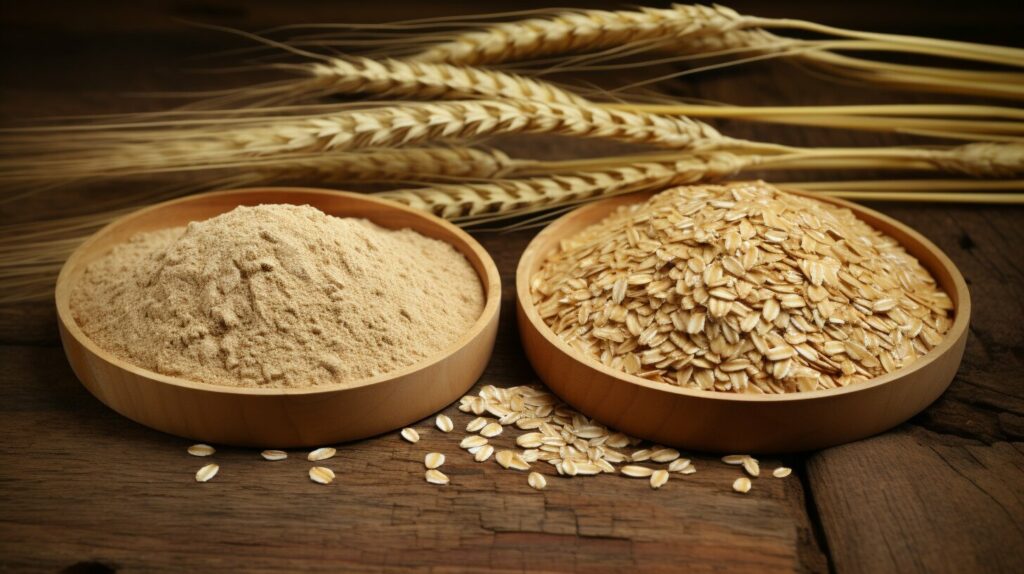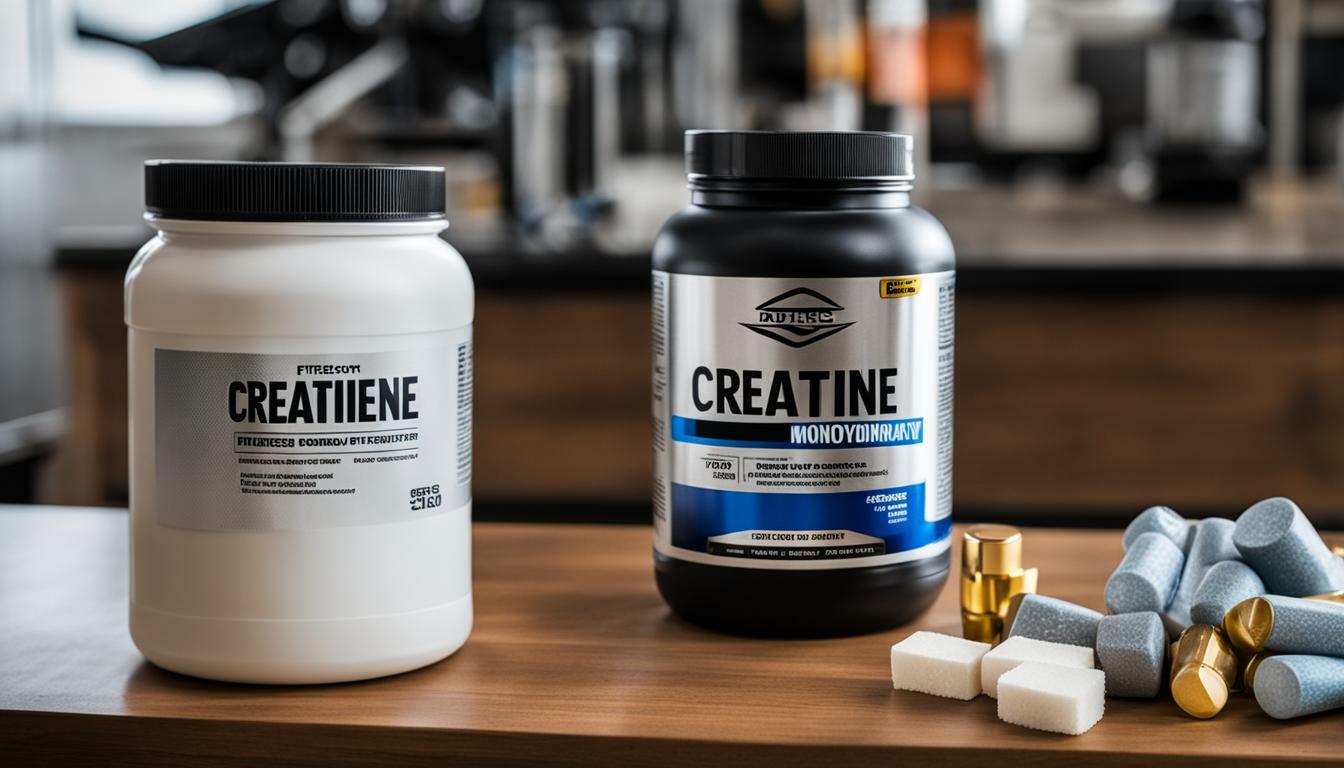When it comes to fiber-rich foods, oat bran and wheat bran are two popular choices. While both offer valuable nutritional benefits, they have some key differences. In this article, we will delve into the variations in nutritional value, dietary benefits, and ways to incorporate them into your diet.
Key Takeaways:
- Oat bran and wheat bran are both nutritious sources of fiber.
- Oat bran is rich in soluble fiber, while wheat bran is high in insoluble fiber.
- Both brans contribute to weight management and provide essential minerals.
- Oat bran is gluten-free, making it suitable for individuals with celiac disease or gluten intolerance.
- Wheat bran may cause digestive issues in some individuals due to its fructan content.
Nutritional Content of Oat Bran vs Wheat Bran
When it comes to nutrition, both oat bran and wheat bran have their unique offerings. Let’s take a closer look at the nutritional content of these two types of bran.
Vitamins
Oat bran and wheat bran are rich sources of vitamins, including vitamin E, vitamin K, thiamin, riboflavin, niacin, vitamin B6, folate, and pantothenic acid. However, wheat bran outshines oat bran in terms of vitamin content. It provides higher levels of thiamin, niacin, vitamin B6, and riboflavin per serving.
Minerals
Both oat bran and wheat bran contain essential minerals that are beneficial for overall health. These minerals include calcium, iron, magnesium, phosphorus, potassium, zinc, copper, manganese, and selenium. Including both types of bran in your diet can help ensure that you’re getting a diverse range of minerals.
| Nutrient | Oat Bran (per serving) | Wheat Bran (per serving) |
|---|---|---|
| Thiamin (mg) | 0.14 | 0.39 |
| Niacin (mg) | 0.71 | 2.19 |
| Vitamin B6 (mg) | 0.19 | 0.47 |
| Riboflavin (mg) | 0.12 | 0.39 |
As shown in the table above, wheat bran provides significantly higher amounts of thiamin, niacin, vitamin B6, and riboflavin compared to oat bran. These vitamins play important roles in energy production, metabolism, and overall well-being.
Incorporating both oat bran and wheat bran into your diet can help you maximize your nutrient intake, providing a wide array of vitamins and minerals that contribute to your overall health.
Fiber Content of Oat Bran vs Wheat Bran
When it comes to fiber content, oat bran and wheat bran offer different benefits. Oat bran is rich in soluble fiber, which forms a gel-like substance during digestion. This type of fiber helps slow down the digestive process, keeping you fuller for longer and aiding in weight management. Oat bran contains approximately 4 grams of fiber per ounce, providing a significant dietary fiber boost for those looking to increase their intake.
On the other hand, wheat bran is high in insoluble fiber. This type of fiber adds bulk to the stool and promotes bowel movement, supporting healthy digestion. Wheat bran has an impressive fiber content of 12 grams per ounce, making it an excellent choice for individuals seeking to improve regularity and overall gut health.
Both oat bran and wheat bran are valuable sources of fiber, but their specific fiber compositions cater to different needs. Consider incorporating both types of bran into your diet to reap the unique benefits of each.
Nutritional Comparison of Oat Bran and Wheat Bran
| Fiber Content per Ounce | Oat Bran | Wheat Bran |
|---|---|---|
| Fiber | 4 grams | 12 grams |
As demonstrated in the table above, wheat bran boasts a significantly higher fiber content compared to oat bran. However, both types of bran contribute to a well-rounded diet rich in fiber, which is essential for maintaining overall health and supporting various bodily functions.
Including oat bran and wheat bran in your diet is an excellent way to increase your fiber intake and support digestive health. Whether you choose oat bran for its soluble fiber benefits or opt for wheat bran to promote regular bowel movements, both can be valuable additions to a balanced diet.
Health Benefits of Oat Bran vs Wheat Bran
Oat bran and wheat bran offer a range of health benefits, although they differ in terms of their specific advantages. Both brans contribute to overall well-being through their nutritional content and ability to support various aspects of health.
Heart Health
Oat bran is particularly beneficial for heart health due to its high content of beta-glucan, a soluble fiber that has been shown to help reduce cholesterol levels. Including oat bran in your diet may lower the risk of cardiovascular disease and support a healthy heart.
On the other hand, wheat bran promotes colon health, which indirectly contributes to heart health. By aiding in the prevention of constipation and promoting regular bowel movements, wheat bran helps maintain a healthy digestive system, reducing the risk of gastrointestinal diseases and ultimately supporting heart health.
Weight Management
Both oat bran and wheat bran play a role in weight management. Oat bran’s soluble fiber content helps you feel fuller for longer and may aid in controlling appetite, which can be beneficial for weight loss or weight maintenance goals. Additionally, oat bran’s higher calorie and fat content make it suitable for individuals looking to gain weight or increase calorie intake.
In contrast, wheat bran is lower in calories and fat, making it a better choice for those seeking to lose weight or maintain a healthy weight. It provides bulk to the stool, aiding in digestion and promoting regular bowel movements. Incorporating wheat bran into your diet can help you feel satisfied while managing calorie intake.
Overall Nutrition
Both oat bran and wheat bran are rich sources of essential minerals, including calcium, iron, magnesium, phosphorus, potassium, zinc, copper, manganese, and selenium. These minerals are important for various bodily functions, such as bone health, immune system function, and energy metabolism. By incorporating both brans into your diet, you can ensure you’re getting a diverse range of nutrients to support overall health.
In summary, oat bran and wheat bran have distinct health benefits. Oat bran offers cholesterol-lowering effects and contributes to heart health, while wheat bran promotes healthy digestion and aids in weight management. By considering your specific health goals and preferences, you can incorporate either or both brans into your diet to reap their respective benefits.
| Health Benefits | Oat Bran | Wheat Bran |
|---|---|---|
| Heart Health | Reduces cholesterol levels | Promotes colon health |
| Weight Management | Controls appetite, suitable for weight gain | Aids in digestion, suitable for weight loss |
| Overall Nutrition | Rich in essential minerals | Rich in essential minerals |
Comparison of Oat Bran and Wheat Bran in Weight Management
Oat bran and wheat bran are both valuable additions to a balanced diet, but they differ in their impact on weight management. Whether you’re looking to gain weight, lose weight, or maintain a healthy weight, incorporating these brans into your meals can support your goals. Let’s explore the unique properties of oat bran and wheat bran in relation to weight management.
Oat Bran for Weight Gain
Oat bran is a calorie-dense food that can be beneficial for individuals aiming to gain weight. It contains significant amounts of carbohydrates, proteins, and healthy fats, making it a nourishing option for athletes, weight trainers, or those with increased caloric needs. Adding oat bran to smoothies, yogurt, or baked goods can provide an energy boost and contribute to weight gain goals.
Wheat Bran for Weight Loss or Maintenance
If your goal is weight loss or weight maintenance, wheat bran can be a valuable ally. It is lower in calories and fat compared to oat bran, offering a nutritious and filling option without excessive caloric intake. The high fiber content of wheat bran adds bulk to your meals, promoting satiety and helping to control appetite. Incorporate wheat bran into your diet by sprinkling it on salads, mixing it into cereals, or using it as a breadcrumb substitute.

Recipes with Oat Bran and Wheat Bran
Whether you’re aiming to gain weight, lose weight, or maintain a balanced weight, there are numerous delicious ways to incorporate oat bran and wheat bran into your meals. Here are a few recipe ideas:
- Oat Bran Recipe: Start your day with a hearty bowl of oat bran porridge topped with fresh fruits and a drizzle of honey.
- Wheat Bran Recipe: Whip up a batch of whole wheat bran muffins with your favorite mix-ins like blueberries, nuts, or chocolate chips.
- Combined Recipe: Create a satisfying breakfast parfait by layering yogurt, oat bran, and wheat bran topped with granola and berries.
Incorporating these recipes into your meal plan can provide a range of nutrients while supporting your weight management goals.
Specific Health Considerations for Oat Bran vs Wheat Bran
When considering the health benefits of oat bran and wheat bran, it’s important to take into account specific health considerations. While both brans offer numerous advantages, there are some differences that individuals should be aware of.
Allergies and Intolerances
Oat bran is a gluten-free option, making it suitable for individuals with celiac disease or gluten intolerance. It provides a safe alternative for those who need to avoid gluten in their diet. On the other hand, wheat bran contains fructans, which are a type of carbohydrate that may cause digestive issues in some individuals. If you have been diagnosed with irritable bowel syndrome (IBS) or other digestive conditions, it’s advisable to consult with a healthcare professional before incorporating wheat bran into your diet.
Cholesterol and Heart Health
Oat bran has been recognized for its potential cholesterol-lowering effects. The beta-glucan fiber found in oat bran may help reduce LDL cholesterol levels, which is beneficial for heart health. Incorporating oat bran into your diet may be particularly advantageous if you have high cholesterol or are at risk of developing heart disease. Wheat bran, on the other hand, supports colon health and estrogen metabolism. It promotes healthy digestion, which is important for overall well-being.

Individual Sensitivities
While both oat bran and wheat bran are generally well-tolerated, it’s essential to pay attention to your individual sensitivities. Some individuals may experience bloating, gas, or other digestive discomfort when consuming large amounts of fiber from either oat bran or wheat bran. It’s recommended to start with small portions and gradually increase your intake to allow your body to adjust. If you experience any adverse reactions, it’s advisable to reduce or eliminate the consumption of the problematic bran.
In summary, oat bran and wheat bran have specific health considerations that individuals should be mindful of. Oat bran is gluten-free and may have cholesterol-lowering effects, while wheat bran contains fructans that may cause digestive issues in some individuals. It’s important to consider your personal health needs and sensitivities when choosing between oat bran and wheat bran, and to consult with a healthcare professional if you have any concerns.
Benefits of Including Oat Bran and Wheat Bran in Your Diet
Both oat bran and wheat bran offer a range of benefits when incorporated into your diet. These nutrient-rich brans contribute to overall health and well-being in various ways, making them a valuable addition to your daily meals. Here are some key benefits of including oat bran and wheat bran in your diet:
1. Promotes Digestive Health
Oat bran and wheat bran are excellent sources of dietary fiber, which supports healthy digestion. Oat bran, with its soluble fiber content, forms a gel-like substance in the stomach, aiding in digestion and promoting feelings of fullness. On the other hand, wheat bran’s insoluble fiber adds bulk to the stool and helps regulate bowel movements. By incorporating both brans into your diet, you can ensure optimal digestive function.
2. Provides Essential Nutrients
Oat bran and wheat bran are packed with essential nutrients that contribute to overall health. They are rich in minerals such as calcium, iron, magnesium, phosphorus, potassium, zinc, copper, manganese, and selenium. These minerals play vital roles in various bodily functions, including maintaining strong bones, supporting immune function, and aiding in energy metabolism. By including oat bran and wheat bran in your meals, you can enhance your nutrient intake.
3. Supports Weight Management
Both oat bran and wheat bran can be beneficial for weight management. Oat bran is higher in calories and fat, making it an excellent choice for individuals looking to gain weight or maintain their weight. On the other hand, wheat bran is lower in calories and fat, making it suitable for those looking to lose weight or manage their weight. By incorporating these brans into your diet, you can support your weight management goals.
| Oat Bran | Wheat Bran | |
|---|---|---|
| Fiber Content (per ounce) | 4 grams | 12 grams |
| Calories (per ounce) | 88 | 70 |
| Total Fat (per ounce) | 2 grams | 1 gram |
Overall, incorporating oat bran and wheat bran into your diet can provide numerous health benefits. They support digestive health, provide essential nutrients, and aid in weight management. Whether you choose to enjoy them as a breakfast cereal or incorporate them into recipes, oat bran and wheat bran are versatile and nourishing additions to a balanced diet. Take advantage of their unique nutritional profiles and reap the benefits they have to offer.

Conclusion
After exploring the nutritional and dietary variations between oat bran and wheat bran, it is clear that both offer unique benefits for overall health and well-being. Oat bran is rich in soluble fiber, making it beneficial for cholesterol reduction and managing diabetes. On the other hand, wheat bran provides insoluble fiber, which supports healthy digestion and bowel function.
When it comes to weight management, oat bran is ideal for weight gain due to its higher calorie and fat content, while wheat bran is a better option for weight loss or maintenance with its lower calorie and fat content. By incorporating both into your diet, you can take advantage of their diverse nutrient profiles and support different weight management goals.
It is important to consider personal health considerations and preferences when choosing between oat bran and wheat bran. Oat bran is gluten-free, making it suitable for individuals with celiac disease or gluten intolerance. However, wheat bran contains fructans, a type of carbohydrate that may cause digestive issues in some individuals.
In conclusion, oat bran and wheat bran each have their own set of nutritional advantages. Whether you prioritize cholesterol reduction, healthy digestion, or weight management, incorporating both into a balanced diet can provide a range of nutrients and support your overall health.
FAQ
What are the main nutritional differences between oat bran and wheat bran?
Oat bran has higher vitamin E, vitamin K, thiamin, niacin, vitamin B6, and riboflavin content compared to wheat bran.
How do the fiber contents of oat bran and wheat bran differ?
Wheat bran has a higher fiber content with 12 grams per ounce, while oat bran contains 4 grams per ounce.
What are the health benefits of oat bran and wheat bran?
Oat bran may help reduce cholesterol levels and manage diabetes, while wheat bran promotes healthy digestion and bowel function.
Which is better for weight management, oat bran or wheat bran?
Oat bran is beneficial for weight gain, while wheat bran is lower in calories and fat, making it suitable for weight loss or maintenance.
Are there any specific health considerations for oat bran and wheat bran?
Oat bran is gluten-free, making it suitable for individuals with celiac disease or gluten intolerance, while wheat bran may cause digestive issues in some individuals due to its fructan content.
What are the benefits of including oat bran and wheat bran in your diet?
Oat bran and wheat bran promote healthy digestion, provide essential nutrients, aid in weight management, and support heart health, blood sugar regulation, bowel function, and the immune system.
 Skip to main content
Skip to main content


